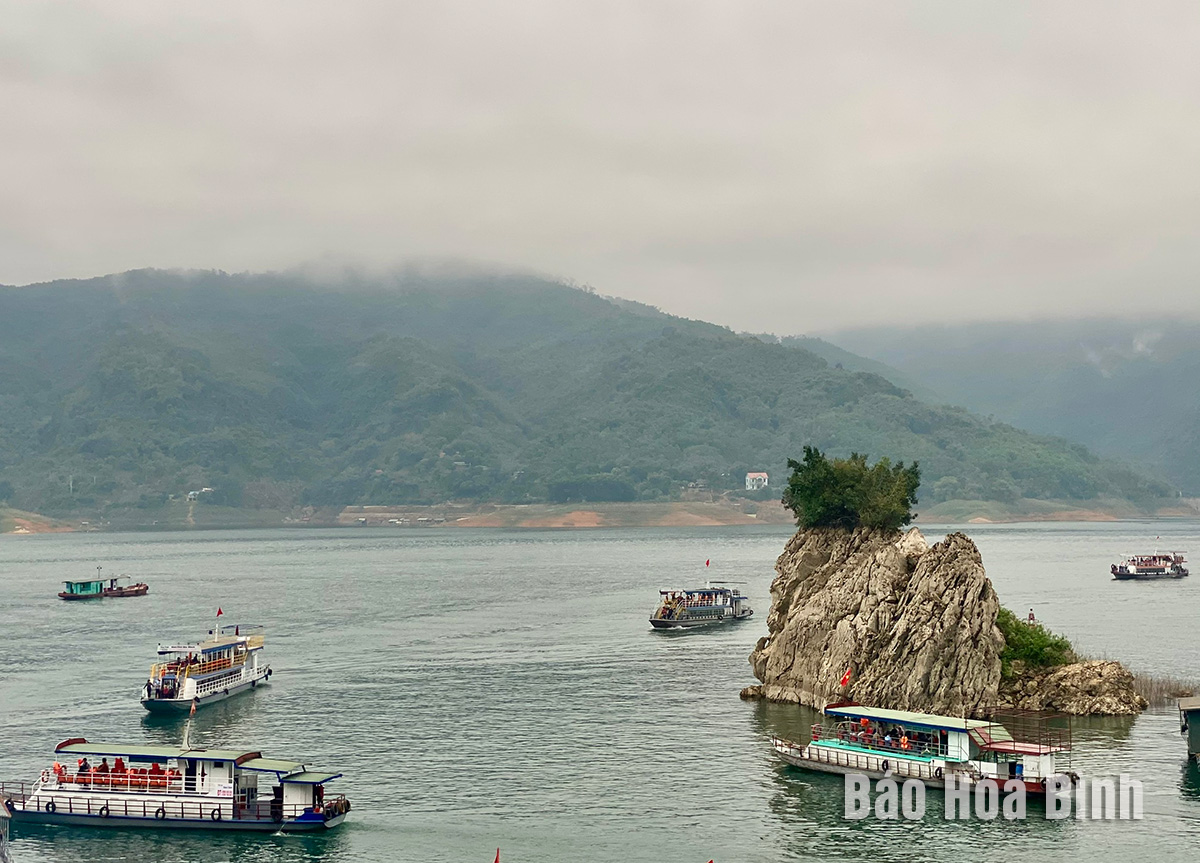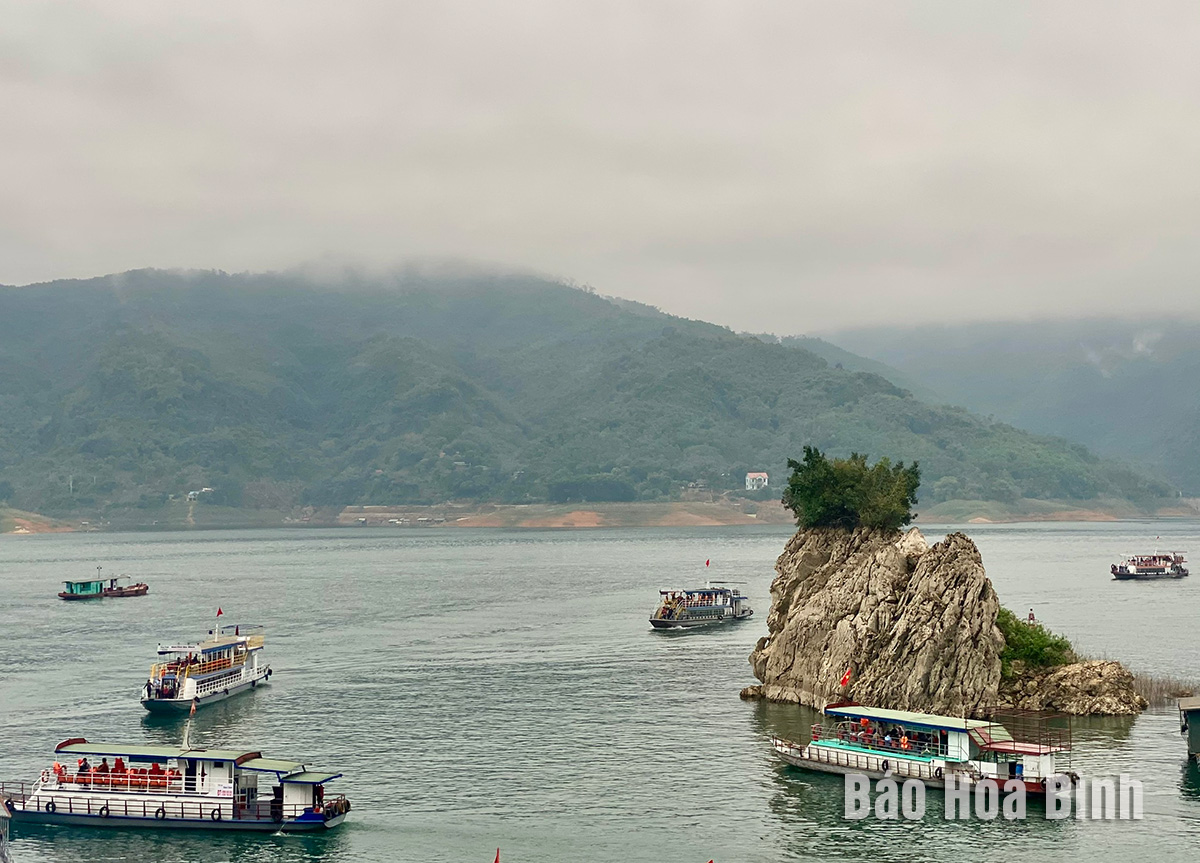
Covering an area of over 52,000 hectares spanning districts of Mai Chau, Tan Lac, Cao Phong, Da Bac, and Hoa Binh City, Hoa Binh lake has strong potential for tourism development. In recent years, thanks to the attention of local Party Committees and authorities as well as support from international organisations, the advantages of tourism in the lake area have been utilised.
Hoa Binh Lake attracts visitors with its natural scenery.
Abundant resources
Coming to Hoa Binh Lake, domestic and international tourists were amazed by the majestic beauty of hundreds of large and small islands nestled amidst the emerald green water which is reminiscent of a "Ha Long Bay in the mountains". It also features a system of caves with various shapes and mesmerising colors.
Hoa Binh Lake boasts numerous tourist attractions, historical and cultural sites, and spiritual tourism sites. The most popular destinations are Thac Bo Temple in Cao Phong District, Thac Bo Cave in Tan Lac District, Hoa Binh Phat Quang Pagoda in Hoa Binh City, Ngoc Hoa Bay, Hoa Tien Cave, Ngoc Island Ecotourism site, Coconut Island, and many villages of Muong and Dao ethic people where traditional culture is still preserved. These are cultural resources for tourism development.
Establishment of community-based tourism destinations
Ten years ago, the Australian non-governmental organisation Action on Poverty (AOP) in Vietnam collaborated with Da Bac District’s administration to carry out community-based tourism project in the locality, in which Da Bia village in Tien Phong commune was chosen as pilot implementation.
According to Dinh Thi Yeu, one of households that take part in the project, in the past, local residents’ livelihoods were dependent on forest plantations and fishing on the lake, thus most of them suffered financial difficulty. With financial support from the project and the government, households have upgraded their stilt houses to provide homestay services for visitors, she said, adding that they have been provided with tourism-related knowledge through training sessions. Cultural values have been preserved while traditional crafts have been revived, she added.
Da Bia has become a famous community-based tourism site. Especially, it is one of the three sites of Vietnam that received the ASEAN Tourism Awards on community-based tourism category at the Asia Travel Forum (ATF) in Hong Kong, China in 2019.
Pham Thu Hoai, a tourist from Hanoi, said Da Bia left a deep impression on her through experiencing locals’ daily activities, adding that she is satisfied with the living space at homestays and services there.
Through capacity-building support, other community-based tourism sites around the lake have been formed and put into operation, including Mo Hem in Tien Phong commune, Ke in Hien Luong commune, Sung in Cao Son commune (Da Bac), Ngoi in Suoi Hoa commune (Tan Lac), Tien in Thung Nai commune (Cao Phong) and Bich Tru in Hoa Binh commune (Hoa Binh City).
Attractive ecological sites
With its unique natural landscape, the Hoa Binh Lake area has been an idea places for organisations, individuals, and businesses to develop eco-tourism.
Mai Chau Hideaway Resort in Mai Chau district’s Son Thuy commune is an example. Describing as a small bay surrounded by green mountains nestled in the heart of the lake, it has become a popular destination to visitors, especially foreign ones.
According to Dang Tuan Hung, Head of Cultural Management Division under the Department of Culture, Sports and Tourism, the establishment of community-based villages and resorts have brought a facelift to the area. Each destination has its own charm, offering tourists a diverse range of products, such as resort and spiritual tourism, experiential travel which involves in the activities and daily life of the locals, such as rowing and swimming on the lake, or trekking through pristine forests and immersing themselves in the lively dances of the friendly Muong and Dao young men and ladies.
The Hoa Binh Lake tourist site has gradually expanded its connectivity with other destinations in the province and waterway routes on the Da River to neighbouring provinces of Hoa Binh, Son La, Dien Bien and Lai Chau. In 2019, it welcomed 550,000 tourists, accounting for 17.7% of the total arrivals to the province, including 26,000 international visitors. The total revenue from the tourism sector reached 160 billion VND (nearly 6.4 million USD).
Located just a 20-minute drive from Hoa Binh City, Ora Hill Farmstay & Glamping Hoa Binh is a captivating new destination nestled in Mo hamlet, Bình Thanh commune, Cao Phong district. Combining farming with leisure, this tranquil retreat is perfect for those seeking balance, joy, and an immersive experience in the expansive beauty of nature.
Muong Bi - Tan Lac is renowned as one of the four famous Muong regions in Hoa Binh province. Blessed by nature with a favourable climate and stunning landscapes, Tan Lac holds great advantages for tourism development. The local tourism industry has made remarkable strides in recent times thanks to the attention and support from the local authorities and sectors.
With its strategic location, well-developed transport network, and diverse soil and climatic conditions, Hoa Binh is emerging as a must-visit destination in Vietnam's northwestern tourism corridor. The province boasts numerous attractions, including the Kim Boi hot springs (Kim Boi district), the Dau Rong cave complex (Cao Phong), the Mai Chau valley (Mai Chau), and the iconic Hoa Binh hydropower plant.
The northern mountainous province of Hoa Binh has been listed among the 71 most beautiful places to visit worldwide by the prestigious US travel magazine Condé Nast Traveller.
Hoa Binh province’s rich natural and cultural resources position it as a prime location for developing community-based tourism (CBT). In recent years, support from central and provincial policies, as well as assistance from non-governmental organisations, have encouraged local ethnic minority and mountainous communities to actively engage in the sector.



